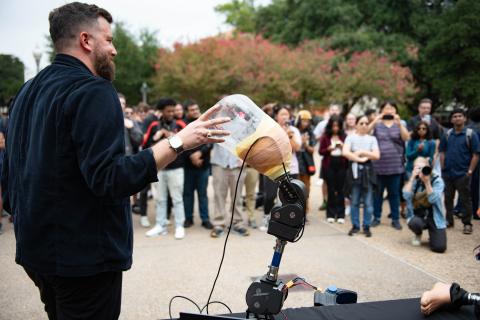News
Nick Fey
Dr. Nick Fey, University of Texas Alumnus, current Texas Robotics Core Faculty, and Director of Systems for Augmenting Human Mechanics Laboratory, is passionate about using engineering for good. His lab is at the forefront of revolutionizing technology for lower-limb robot prosthetics and assistive devices.

As a University of Texas Alumnus, Dr. Nick Fey is driven by a passion for changing the world through engineering. He graduated from The University of Texas at Austin with a bachelor’s, a master’s, and a doctoral degree in Mechanical Engineering. He pursued postdoctoral research in the Center for Bionic Medicine at the Shirley Ryan AbilityLab (formerly the Rehabilitation Institute of Chicago) and Northwestern University’s Feinberg School of Medicine.
Since returning to the University of Texas to work for the Walker Department of Mechanical Engineering and Texas Robotics, Nick Fey became the Director of the Systems for Augmenting Human Mechanics Laboratory, through which he researches robotic devices for individuals with lower limb loss.
This includes a broad and diverse range of projects such as developing robotic knees and ankles, creating individualized techniques for amputation surgeries, understanding human movement compensations for persons with lower leg amputations, using machine learning for understanding and predicting human movement, leveraging predictive neuromuscular modeling, creating wearable braces to counteract compensation, and predicting intended movement using ultrasound wearables. When combined, the research topics from SAHM have the potential to revolutionize lower-limb wearable mobility aids.
“Every person who has a lower leg amputation is going to be different because of their compensations and needs, and that was something, as a field of study, we hadn’t explored…. The unified approach of creating a standard prosthetic wasn’t effective in creating the intended biomedical benefits.” - Dr. Nick Fey
Today, Nick’s lab strives to converge and integrate their research to develop a system that will give the best possible experience to lower limb prosthetic users. Prosthetics, wearable devices, and other mobility aids have been instrumental in restoring mobility to patients with lower limb loss, but technological limits have dulled their effectiveness. Robotic prosthetics represent not merely a leap in technical prowess but a gateway to enhanced mobility and a broader spectrum of life-enriching activities for individuals with lower limb loss.
Among the problems that SAHM hopes their research will address are degenerative diseases such as osteoporosis and arthritis that cause chronic pain for lower limb prosthetic users. These issues develop from the compensations that patients leverage in response to the limits of their prosthetics. The pain can significantly reduce the mobility of a patient with a lower limb prosthetic, even to the point of being unable to walk.
As a whole, the goal of SAHM lab is to build prosthetics that improve quality of life, which includes reducing medical compensations and allowing patients to navigate daily life with greater ease and actively participate in a diverse array of activities previously deemed challenging or inaccessible.
“The movement allowed by current prosthetic limbs restrict the types of movements people can do […] It’s not just about physical health, but quality of life. Can you play the sports that you want? Can you get the types of jobs that require your mobility? Can you perform your life's pursuits in the way that you want?” - Dr. Nick Fey
As Nick and the entirety of the lab continue their research, it is undeniable that they are at the forefront of developing robotics systems that genuinely improve people’s lives.